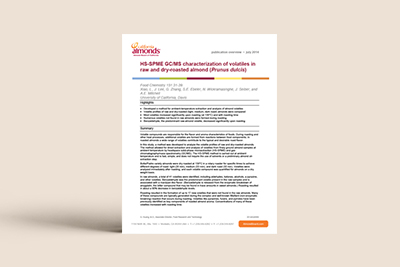Physical Attributes
The basic physical elements of almond quality are grade, variety, size, and specification.

The basic physical elements of almond quality are grade, variety, size, and specification.
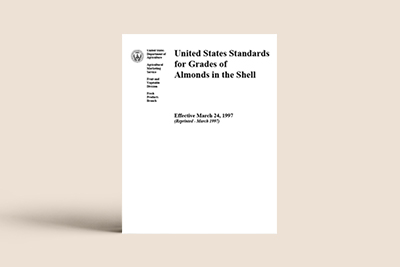
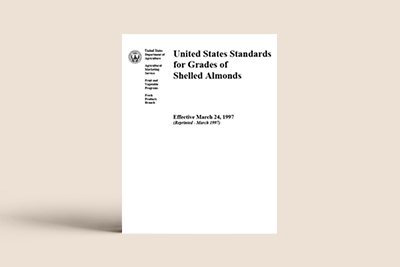
Almonds have a quality nutrient profile, which includes important macronutrients like protein (6 grams per serving), monounsaturated fatty acids (8.9 grams per serving) and are a good source of dietary fiber. They are also an excellent source of both the micronutrient, vitamin E and the mineral magnesium, and also provide 75mg per serving of calcium. Composition data for California almonds are found in the USDA National Nutrient Database. The USDA nutrient data sets, available for natural almonds, almond forms, and roasted almonds, represent a comprehensive sampling of California-grown almonds. For natural almonds, the USDA nutrient values are averages based on more than 70 samples of nine major almond varieties grown in California over several years.
Current research shows that there are no major differences in nutrient composition among the major California almond varieties. Nutrient contents can vary from sample to sample, even within a variety, because almonds are natural products. In general, the growing conditions (region, crop year and production factors) have a greater effect on nutrient composition than does the almond variety.
A study published in the Journal of Food Composition and Analysis compared the nutrient profiles of seven major almond varieties (Butte, Carmel, Fritz, Mission, Monterey, Nonpareil and Sonora). Almond samples were collected over three separate harvest years and from orchards in the north, central and south growing regions in California. Comprehensive analysis of macronutrients, micronutrients and phytosterols in the almond samples was carried out by accredited laboratories. The study found that these California almond varieties had very similar macronutrient and micronutrient profiles. For example, the content of total fat and monounsaturated fatty acids was the same in all the varieties.
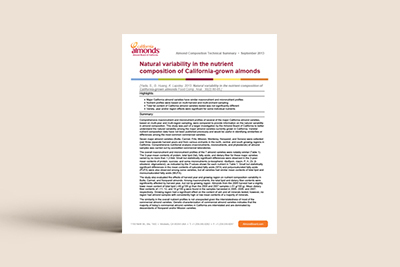
In California, all almond trees growing in commercial orchards produce “sweet” varieties of almonds. The sweet or bitter flavor of an almond variety depends on the genetics of the parent tree in the orchard.
Almonds can be characterized by three flavor phenotypes: sweet (non-bitter), slightly bitter (or semi-bitter), and bitter. In general, a naturally occurring compound known as amygdalin is responsible for bitterness in almonds. Amygdalin is found in almond kernels and in the seeds of stone fruits like apricots. Bitter almonds contain high levels of amygdalin (3–5%), whereas only trace levels are found in almonds from sweet varieties (<0.05% amygdalin) and from slightly bitter varieties (<0.2% amygdalin). Bitter almonds are used mainly in the production of almond pastes and almond-flavored extracts.
Amygdalin breaks down to release hydrogen cyanide as well as sugars (glucose) and benzaldehyde. Hydrogen cyanide and benzaldehyde have similar aromas and are responsible for the bitter taste in almond kernels. Benzaldehyde, which is nontoxic, is extracted from bitter almonds and is an important flavoring substance also known as “oil of almond” or almond essence.
To better categorize the flavor of sweet and slightly bitter almond varieties, it is important to be able to accurately measure the amount of amygdalin present. Until recently, very little information was available on the differences in trace amygdalin levels among the commercial almond varieties grown in California.
In a study conducted at the University of California, Davis, researchers developed a highly sensitive method to analyze for amygdalin levels in almonds. They used this method to compare the amygdalin levels in 10 commercial varieties of California almonds (sweet), and found that some varieties (e.g., Fritz and Aldrich) had slightly higher amygdalin levels. More research needs to be conducted on almonds harvested in different years to find out whether amygdalin levels in these varieties are consistently higher.
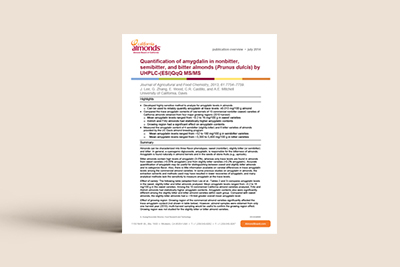
Quantification of amygdalin in non-bitter, semi-bitter and bitter almonds (Prunus dulcis) by UHPLC-(ESI)QqQ MS/MS. Journal of Agricultural and Food Chemistry, 2013, 61(32):7754–7759.
The sensory characteristics of almonds can be described by an array of attributes. Distinctive texture attributes can include roughness, crunchiness, hardness, particulate mass, cohesiveness and adhesiveness, and be crispy and chewy. Typical almond aroma/flavor attributes can include overall intensity, fruity, marzipan (benzaldehyde), dark chocolate, nutty, woody, toasty and earthy.
A sensory lexicon is like a vocabulary of terms that can be used to describe and document the attributes of a product. In very simple terms, texture is evaluated for the almond surface, the various chewing stages, and the residual attributes after chewing. Aroma is evaluated by smelling the almonds before chewing. Flavor is evaluated as the in-mouth flavor impact as the nuts are chewed.
In a study at the University of Minnesota, researchers evaluated the sensory texture attributes of five types of almond forms (natural whole, dry-roasted whole, blanched whole, blanched slivered and natural sliced) at different moisture levels. Some of their findings about almond texture are listed below.
Natural raw whole almonds are high in crunchiness, hardness, and cohesiveness while dry-roasted almonds are generally harder, crispier, crunchier and produce more loose particles. Natural almonds are harder, crisper and crunchier than blanched almonds. Compared with whole almonds, sliced and slivered almonds have less hardness, crunchiness, cohesiveness and tooth packing, and require fewer chews and swallows to consume. Compared with slivered almonds, sliced almonds are more powdery and have more surface roughness and loose particles, as well as less hardness, moistness, and cohesiveness of mass and fatty film. Sliced almonds broke into fewer pieces and required fewer chews and swallows to consume than did slivered almonds.
Almond texture is closely correlated with moisture. Sensory testing of texture showed that as moisture increases, moistness of mass and cohesiveness of mass increase. Crispness, hardness, crunchiness, persistence of crunch, and particulate mass decrease with increasing moisture content. Consumers like crispness, crunchiness, and persistence of crunch.
Texture can also be measured with instruments by using compression or bending tests. Read more about texture measurements and moisture.
Volatile compounds are responsible for the aroma and flavor attributes of foods. The almond lexicon study showed that the intensities of aroma/flavor attributes in raw almonds are relatively low, ranging between 0 and 5, which is indicative of mild-flavored products. The major California almond varieties evaluated show a range of inherent variability in aroma/flavor attributes. This variability within an almond variety also may be influenced by crop years and growing regions.
A wide range of volatile compounds exists in raw, aged, and roasted almonds. But the dominant flavor compound in raw almonds is benzaldehyde. Other volatile compounds in raw almonds include short-chain branched alcohols, aldehydes, and ketones. Benzaldehyde is a breakdown compound released from the hydrolysis of amygdalin (download PDF below), a compound responsible for bitterness in almonds. California almonds are sweet varieties that contain only trace amounts of amygdalin. Roasting diminishes the benzaldehyde intensity, which then may not be perceivable from sensory evaluation.
Flavor volatiles in roasted almonds are dominated by volatiles such as pyrazines and branched aldehydes and ketones generated during the browning reaction (also known as the Maillard reaction). The degree of roasting dictates the flavor intensity of roasted almonds.
Researchers at the University of California, Davis, have evaluated the volatile compounds in raw and roasted almonds (download PDF below).
Development of an almond lexicon to assess the sensory properties of almond varieties. Civille, G.V., K. Lapsley, G. Huang, S. Yada, J. Seltsam. Journal of Sensory Studies, 2010, 25(1):146–162.
Impact of almond form and moisture content on texture attributes and acceptability. Vickers, Z., A. Peck, T. Labuza, G. Huang. Journal of Food Science, 2014, 79(7):S1399–S1409.
HS-SPME GC/MS characterization of volatiles in raw and dry-roasted almonds (Prunus dulcis). Xiao, L., J. Lee, G. Zhang, S.E. Ebeler, N. Wickramasinghe, J. Seiber, A.E. Mitchell. Food Chemistry, 2014, 151:31–39.


